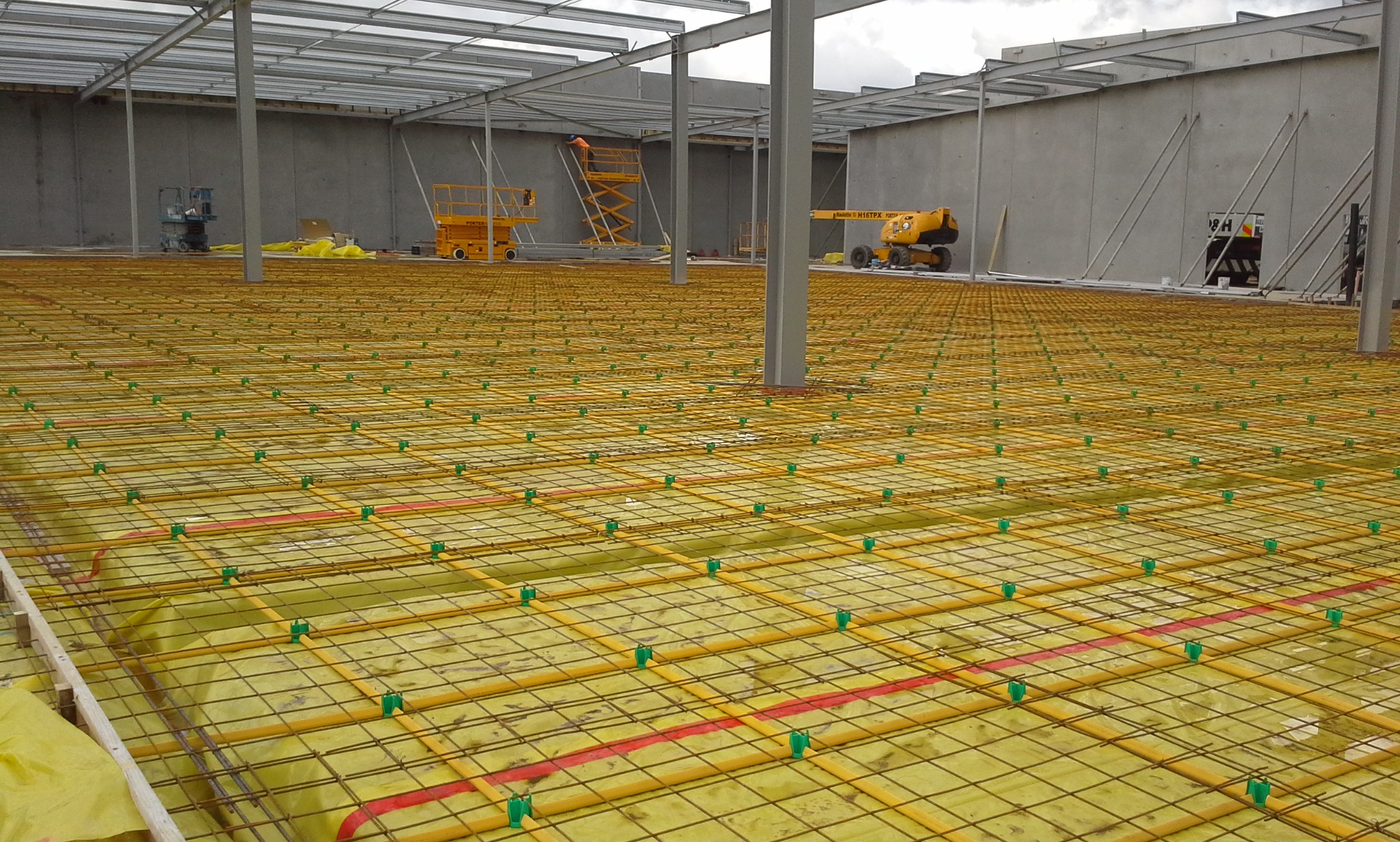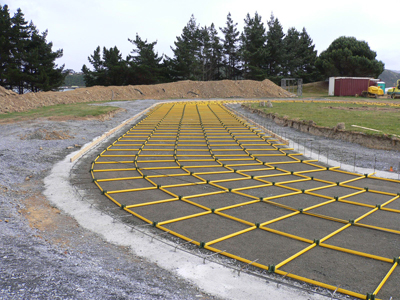


Read about the innovative slab-on-ground construction method creating substantial construction savings.

Jointed slabs-on-ground can be constructed using either plain or reinforced concrete. In both cases, the slab thickness is selected so that the flexural stresses in the slab will be less than the flexural capacity of the concrete alone. While the methods for selecting joint spacing in the respective slab types are based on traditional rules1 or calculation of subgrade drag forces,2 the goal is to select a spacing that minimizes the number of required joints, yet prevents intermediate cracking. In practice, joints are often formed by sawing the concrete at an early age to induce a through-thickness crack above carefully located load-transfer devices. Joints in industrial slabs are often filled with a semi-rigid filler to protect the edges against damage. An alternative to jointed slab construction, termed joint-free slab construction, was introduced in North
America at the 2006 World of Concrete. This type of slab is constructed using
a grid of crack inducers that are positioned at the base course, before the concrete is placed. As the slab hardens and shrinks, a closely spaced, regular network of fine cracks is formed above the grid, thus eliminating the need for joints.
The joint-free slab system therefore avoids one of the main issues with saw-cut control joints in traditionally detailed slabs-on-ground: making sure the saw cuts are installed before microcracks form in the concrete. Because joint-free slabs don’t require saw-cut joints, this issue, along with many others, doesn’t exist.
With the joint-free slab system, the crack inducer grid used in Australia is a 1 m (3 ft, 3 in.) square grid comprising extruded polymer, teardrop-shaped tubes, and injection moulded, four-way junctions. The plastic tubes are supplied cut to length, and the grid is assembled on site with the tubes fitting snugly onto the junctions. The tubes are sized so that their height is about 1/4 the slab thickness. A 30 mm (1-1/8 in.) high crack inducer is used for 90 to 110 mm (3-1/2 to 4-1/2 in.) thick slabs and a 38 mm (1-1/2 in.) high crack inducer is used for 120 to 135 mm (4-3/4 to 5-3/8 in.) thick slabs. When there is adequate ongoing demand, production of larger crack inducers for thicker slabs is anticipated. The junctions double as bar chairs to provide support for welded-wire reinforcing. The height of the junctions has been set to achieve a minimum 40 mm (1-1/2 in.) cover in 100 and 125 mm (4 and 5 in.) thick slabs.

In contrast to jointed slabs, where subgrade drag must be minimized, joint-free slabs require ground restraint to ensure that cracks are induced on a regular spacing. This restraint is normally provided by 300 mm (12 in.) wide, 200 mm (8 in.) deep trenches placed at the full perimeter of the slab as well as on a 15 m (50 ft) grid throughout the slab area.
To minimize costs as well as reduce the amount of shrinkage, the concrete strength should be kept to the minimum required to satisfy durability and flexural
strength requirements (excessive concrete strength will actually be detrimental, as it will make it less likely that cracks will be induced early in the slab’s life). It’s also recommend that the specified 56-day drying shrinkage be no more than 600 micro strain.
Past installations have successfully used 200 x 200- MW29 x MW29 (8 x 8-W4.5 x W4.5) welded-wire reinforcing mats to limit the maximum crack width to about 0.5 mm (0.02 in.). Heavier reinforcement is recommended, however, for installations where the slab surface will be exposed or the slab thickness is greater than 125 mm (5 in.). It’s also recommended that the full perimeter of each slab placement be trimmed with two No. 13 (No. 4) deformed bars and that trim bars be installed at re-entrant corners and penetrations. With no special treatment, vinyl tiles, sheet vinyl, and carpet have been successfully applied over the system’s induced cracks. To prevent reflective cracks, ceramic tiles have been installed using a 3 mm (1/8 in.) thick layer of flexible adhesive, and terrazzo and epoxy concrete toppings have been installed over continuous membrane bond breakers.
Using the new system, the direct savings in construction cost can be substantial, as: n Formed or saw-cut control joints aren’t required; n Sealants and joint fillers aren’t generally required; n Compressible isolation material isn’t needed at restraints (for example, columns and pipes); n The junctions for the grid serve as supports for the slab reinforcement, significantly reducing the need for traditional bar chairs; n Without joints requiring temporary filling, the slab provides a superior casting surface for tilt-up construction; and
n The installation of some applied finishes is simpler, as there is no need for placing cover strips and cutting in joints in the finish material; The system can also provide long-term savings for the owner. For example, maintenance of control joints that can fail under the impact action of fork lifts and pallet movers is effectively eliminated. Slabs constructed using the system have been subjected to warehouse traffic consisting of fork lifts with solid rubber tires, lift capacities of 2 to 4.5 tonnes (2.2 to 5 tons), and front axle loads more than twice the lift capacity. The slabs have also been subjected to supermarket receiving-dock traffic consisting of pallet movers or pallet jacks with small diameter steel wheels. Experience gained from these installations has shown that the system is quite durable. The narrow cracks induced do not produce the joint impact that leads to the degradation of unfilled joints, and the small diameter rubber or steel wheels simply ride over the cracks as they do in joints filled with semi-rigid joint filler.
Since the summer of 2000, the joint-free slab system has been used on a wide variety of projects in Australia. Within just 12 months of its launch, the system received industry recognition in the form of an excellence certificate awarded by the Concrete Institute of Australia. To date, over 200,000 m2 (2,200,000 ft2) of joint-free slabs have been placed, and the system is being repetitively used in projects for large Australian retailers.
We won't bombard you with emails. Stay updated with industry news and new products.